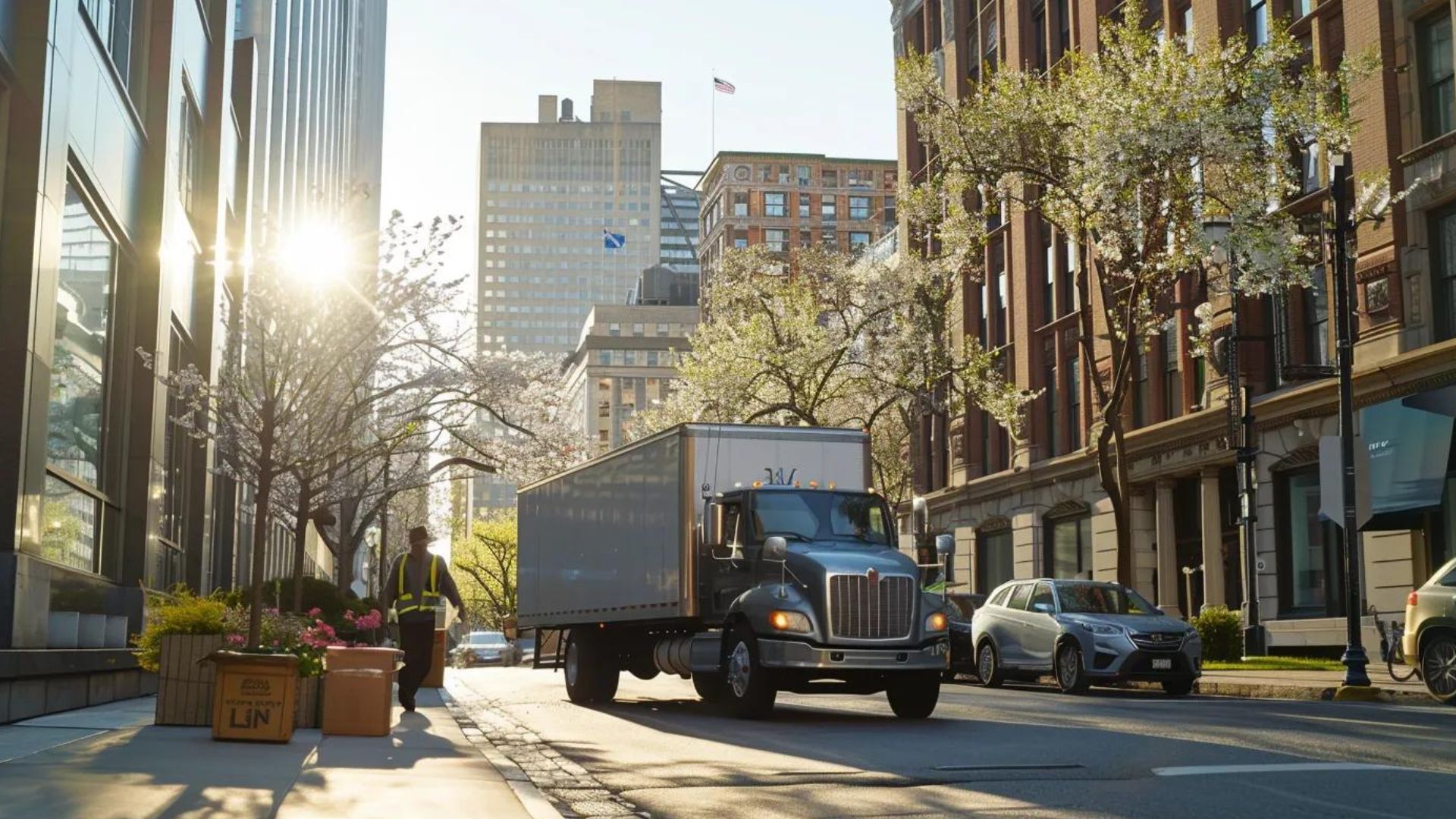Commercial Movers vs DIY: Why Choose Professionals?
Commercial Movers vs DIY: Why Choose Professional Office Movers for a Successful Business Relocation

Could an avoidable decision cost your company thousands in lost productivity? Businesses face a pivotal choice when planning an office relocation, and the benefits of hiring commercial movers consistently outweigh the apparent savings of a do-it-yourself approach. In this guide, we examine minimized downtime, enhanced safety protocols, specialized equipment, workforce relief, and insurance protection. You’ll also discover hidden DIY risks, cost comparisons, when DIY makes sense, criteria for selecting a mover, Anchor Point Moving’s proven methodology, and a step-by-step relocation checklist.
What Are the Key Benefits of Hiring Professional Commercial Movers?
Key benefits of hiring professional commercial movers include reduced operational interruptions, secure handling of high-value assets, and streamlined coordination from packing through setup. For example, expert teams can reduce relocation timelines by up to 50%, resulting in immediate productivity gains.
The Impact of Workplace Relocation on Employee Productivity - in English
Research indicates that poorly managed office relocations can lead to significant drops in employee productivity due to factors like downtime, stress, and unfamiliarity with the new workspace. Studies show that well-planned moves, with professional assistance, can mitigate these negative impacts, resulting in a smoother transition and a quicker return to normal operations.
By leveraging trained crews and efficient logistics, businesses can safeguard continuity and protect sensitive equipment. This foundation leads directly into how downtime is minimized during an office relocation.
How Do Professional Movers Minimize Business Downtime During Office Relocation?

Professional movers minimize business downtime by orchestrating staged packing, off-hour transport, and rapid on-site setup. These specialists define critical path tasks—such as server disconnection and furniture reassembly—so workstations come online swiftly.
- They schedule sectional moves to keep essential departments operational.
- They prepare inventory and floor plans in advance to expedite placement.
- They coordinate with IT teams for parallel disassembly and reinstallation.
This precise sequencing ensures operations resume quickly and lays the groundwork for equipment protection measures.
What Safety Measures Do Commercial Movers Use to Prevent Equipment Damage?
Commercial movers enforce rigorous safety protocols to prevent equipment damage, employing padded dollies, protective shrink wrap, and cradle-style lifting harnesses. They also use calibrated forklifts and adjustable ramps for heavy assets.
| Protection Method | Equipment Covered | Benefit |
|---|---|---|
| Padded Dollies | Computers, Printers | Eliminates scratches and shocks |
| Crate-Style Lifting Harness | Filing Cabinets, Servers | Ensures balanced lifting and secure grip |
| Climate-Controlled Transport | Sensitive Electronics | Maintains stable temperature and humidity |
Each method reinforces secure transit and transitions into how expertise and tools drive efficiency.
How Does Expertise and Specialized Equipment Improve Moving Efficiency?
Professional movers combine industry knowledge with purpose-built equipment—such as lift gates, modular racks, and heavy-duty shrink wrap—to accelerate relocation phases. Their familiarity with office layouts and asset handling reduces trial-and-error delays.
For instance, customized rigging systems adapt to stairwells and high-ceiling lobbies, avoiding costly elevator scheduling conflicts. This specialized approach naturally eases employee workload and stress.
In What Ways Do Professional Movers Reduce Employee Stress and Workload?
By handling all packing, labeling, transport, and reassembly, professional movers liberate internal teams from physical labor and logistical coordination. Employees remain focused on core responsibilities, eliminating the need for overtime or temporary staffing.
- Reducing manual heavy lifting prevents strain injuries.
- Offloading setup tasks frees IT staff for system testing.
- Centralizing move communications ensures clarity and accountability.
This relief factor ties directly into comprehensive insurance protections that mitigate risk.
What Insurance and Liability Protections Do Commercial Moving Services Provide?
Commercial moving services include transit, cargo, and liability coverage to safeguard assets from loss or damage. These policies often exceed basic carrier protections and can cover the full replacement value of equipment and fixtures.
| Coverage Type | Typical Limit | Advantage |
|---|---|---|
| Transit Insurance | Up to 100% replacement | Full reimbursement for damaged items |
| General Liability | $1 million per incident | Protects against property claims |
| Worker’s Compensation | Statutory limits | Covers employee injuries on-site |
Comprehensive coverage ensures peace of mind and prepares us to explore the hidden costs of a DIY office move.
What Are the Hidden Risks and Costs of a DIY Office Move?

Attempting a DIY office move introduces physical hazards, property damage, and unplanned expenses that often outstrip projected savings. For example, a single fractured server rack can halt operations, incurring both repair and downtime costs.
Identifying these risks highlights why professional support pays dividends, beginning with employee injury potential.
How Does DIY Moving Increase the Risk of Employee Injuries?
DIY moving exposes staff to heavy lifting, awkward loads, and unfamiliar handling equipment, leading to strains, sprains, and more serious injuries. According to industry data, musculoskeletal injuries account for over 60% of workplace accidents during in-house relocations.
- Lifting without mechanical aids increases back injury rates.
- Navigating bulky furniture through narrow halls raises trip hazards.
- Improper tool use can result in lacerations or crush injuries.
Occupational Injuries in the Moving and Storage Industry
Data from the Bureau of Labor Statistics highlights the risks of musculoskeletal injuries in the moving and storage industry, which includes office relocations. The research emphasizes that improper lifting techniques and inadequate safety measures are major contributors to these injuries.
These safety concerns segue into the extensive property damage common in DIY moves.
What Types of Property Damage Are Common in DIY Business Relocations?
When untrained personnel handle office assets, scratches, dents, and breakages occur frequently. Servers, glass partitions, and ergonomic chairs are particularly vulnerable without custom packing and rigging.
| Asset Category | Common Damage Type | Consequence |
|---|---|---|
| IT Hardware | Overheating, Shock | Data loss, expensive repairs |
| Office Furniture | Scratches, Broken Parts | Replacement costs and delays |
| Facility Fixtures | Wall gouges, Door warps | Repair work and aesthetic impact |
Understanding these damage vectors underscores the next hidden cost: prolonged downtime.
How Does DIY Moving Lead to Extended Business Downtime and Lost Productivity?
Without professional coordination, tasks overlap and bottlenecks arise—IT teams wait for desks, facilities staff juggle equipment, and departments pause. This misalignment can extend relocation by days or weeks instead of hours.
Extended downtime translates into lost billable hours, delayed customer service, and potential revenue setbacks. That financial erosion points directly to unforeseen expenses.
What Hidden Expenses Should Businesses Expect When Moving Themselves?
DIY relocations often incur unplanned costs such as equipment rentals, overtime wages, repair bills, and expedited replacement fees. These add up rapidly once initial budgets have been exceeded.
- Renting specialty dollies or lift gates at premium rates
- Paying for last-minute contractors to repair walls and floors
- Covering expedited data recovery after hardware damage
These budget overruns intensify stress and logistical strain on internal teams.
Why Does DIY Moving Cause Stress and Operational Challenges for Internal Teams?
Tasking employees with move planning and execution diverts focus from core business objectives, creating frustration and burnout. The lack of clear leadership and standardized processes compounds confusion.
Ultimately, this operational turmoil prepares the case for an informed cost comparison between DIY and professional moving.
How Do Commercial Moving Costs Compare to DIY Office Relocation Expenses?
Comparing commercial moving costs to DIY outlays reveals that professional rates often represent a strategic investment rather than an expense. A full-service relocation can actually save money by eliminating hidden fees and minimizing downtime.
The side-by-side cost breakdown highlights this value proposition.
| Office Size | Average Professional Cost | Typical DIY Expense |
|---|---|---|
| Small (1-10 desks) | $1,000–$5,000 | $1,500–$6,500 |
| Medium (11-50 desks) | $5,000–$20,000 | $7,000–$25,000 |
| Large (51+ desks) | $30,000+ | $40,000+ |
Recognizing these disparities leads us to examine the factors that drive professional pricing.
What Factors Influence the Cost of Professional Commercial Moving Services?
Several attributes determine a commercial move’s pricing, including distance, building access, scope of services, and time constraints. Understanding these drivers helps secure accurate estimates.
- Distance and transit logistics affect fuel and labor charges.
- Special handling requirements for IT or fragile assets increase fees.
- Service scope—from full packing to partial loading—dictates crew size.
- Off-hour or weekend scheduling may incur premium rates.
These cost elements inform average pricing tiers for different office sizes.
How Do Average Costs Vary for Small, Medium, and Large Office Moves?
Professional movers calculate labor hours, equipment needs, and travel time to determine quotes. Larger moves benefit from economies of scale, whereas small moves may incur a minimum charge.
A closer look reinforces why small teams sometimes opt for DIY despite the latent risks.
What Hidden Costs Are Often Overlooked in DIY Office Moves?
DIY planners frequently underestimate:
- Packing materials and specialty crates
- Equipment rental deposits and damage fees
- Temporary storage and climate control expenses
- Unexpected service charges for elevator or parking permits
These omissions can inflate budgets and justify professional engagement.
How Can Businesses Get Accurate Quotes and Avoid Unexpected Fees?
To secure transparent pricing, businesses should request detailed line-item estimates, clarify service inclusions, and confirm permit responsibilities.
- Ask for a breakdown of labor, materials, and ancillary fees.
- Verify access requirements and confirm any building restrictions.
- Ensure insurance coverage details are clearly spelled out.
With precision estimates in hand, teams can then explore cost-saving tactics.
What Cost-Saving Strategies Can Make Professional Moving More Affordable?
Employing planning and negotiation techniques can reduce relocation expenses without sacrificing quality.
- Schedule moves during off-peak weekdays to lower rate premiums.
- Consolidate packing materials and recycle sturdy crates.
- Bundle services—such as packing and storage—for package discounts.
- Provide an accurate inventory to prevent scope creep.
These strategies ease budgetary pressure and transition us to situations where DIY might still be viable.
When Might a DIY Office Move Be a Viable Option?
A DIY office move can succeed for very small teams with minimal equipment and flexible timelines. When only a few desks require relocation and no specialty assets are involved, in-house execution may make sense.
This scenario sets up criteria for identifying suitable DIY moves.
What Types of Moves Are Suitable for DIY Relocation?
DIY relocation works best when:
- Only desktop workstations and office chairs need moving.
- The new location is in the same building or adjacent floor.
- Employees have basic manual-handling training.
- There are no high-value electronics or fragile assets to transport.
These conditions allow in-house teams to manage the move quickly and safely.
How Can Small Businesses Prepare for a Successful DIY Move?
Proper planning and resource allocation mitigate DIY risks.
- Develop a move timeline with clear milestones.
- Assign a dedicated move coordinator to oversee tasks.
- Secure necessary equipment rentals in advance.
- Train staff on safe lifting techniques and emergency procedures.
Even with preparation, limitations remain that warrant consideration.
What Are the Limitations and Risks Even in Small DIY Moves?
Even modest relocations carry potential for delays, minor damages, and employee strain. Without specialized tools, teams may still face bottlenecks that extend downtime beyond planned windows.
Evaluating these constraints guides businesses toward making an informed choice between DIY and professional services.
How to Choose the Right Commercial Moving Company for Your Business?
Selecting an experienced commercial mover involves evaluating credentials, reputation, and service offerings to align with your relocation objectives. A systematic approach ensures you partner with a mover who delivers on time, within budget, and without surprises.
Key selection criteria clarify this decision.
What Key Criteria Should You Evaluate When Selecting Professional Movers?
When choosing a mover, assess these core attributes:
- Experience with projects of similar size and complexity.
- Proper licensing and insurance documentation.
- Availability of specialized services, such as IT equipment handling.
- Clear communication protocols and responsiveness.
Evaluating these factors leads to deeper insight into reputation and reviews.
How Do Customer Reviews and Reputation Influence Your Choice?
Customer feedback provides real-world validation of a mover’s performance. Consistent praise for punctuality, care, and problem-solving indicates reliable service delivery and reduces selection risk.
A strong reputation smoothly guides us to the next consideration: specialized services.
What Specialized Services Should You Look for in a Commercial Moving Provider?
Companies relocating sensitive electronics, fine art, or bulky conference tables benefit from:
- Certified IT relocation teams with anti-static protection
- Custom crate fabrication for fragile items
- White-glove unpacking and workspace setup
- Secure document shredding and disposal
Identifying these services underscores the importance of clear communication.
How Important Is Communication and Customer Service During Your Move?
Transparent, proactive communication ensures alignment on schedules, access constraints, and contingency plans. A dedicated account manager and real-time updates foster trust and reduce last-minute surprises.
This customer-centric approach naturally leads to transparent pricing practices.
How Can You Get Detailed and Transparent Moving Estimates?
Request written proposals that itemize labor rates, equipment fees, and potential surcharges. Confirm whether quotes include packing materials, insurance premiums, and travel time to avoid post-move billing adjustments.
Armed with clear estimates, businesses can confidently engage their chosen provider and witness how Anchor Point Moving delivers on promises.
How Does Anchor Point Moving Ensure a Seamless and Efficient Commercial Relocation?
Anchor Point Moving combines disciplined project management, specialized equipment, and an experienced team to deliver efficient, low-stress commercial relocations. Our structured process minimizes disruption and safeguards every asset.
Our approach originates with a standardized yet flexible framework.
What Is Our Specialized Commercial Moving Process?
- Site Assessment – Conduct on-site surveys to map spaces and clarify access.
- Custom Planning – Develop tailored move plans with detailed timelines and floor layouts.
- Coordinated Packing – Use labeled crates and protective materials for secure transport.
- Precision Transport – Deploy climate-controlled vehicles and GPS tracking.
- Efficient Setup – Reassemble workstations and test equipment before hand-off.
This methodology transitions into customized solutions for each client’s unique needs.
How Do We Customize Moving Solutions for Different Business Needs?
Anchor Point Moving adapts to diverse requirements by:
- Scaling crew size for small startups or large enterprises
- Offering after-hours service for zero-downtime relocations
- Integrating IT partners for seamless system migrations
- Providing interim storage with climate control and secure access
These tailored services rest on our commitment to safety and efficiency.
What Safety and Efficiency Commitments Set Us Apart?
Our core commitments include:
- Zero-Damage Guarantee for high-value assets
- On-Time Performance Warranty with financial penalties for delays
- Dedicated Safety Officers at every site
- Real-Time Move Tracking for heightened visibility
These guarantees culminate in dependable service and prepare teams for effective planning.
What Are the Essential Steps in Planning a Successful Office Relocation?
A successful office relocation begins with structured planning that addresses timelines, inventory, technology infrastructure, communication, and execution logistics. Clear project management ensures each phase aligns with business priorities.
These foundational steps guide an effective move.
How Should Businesses Manage Pre-Move Planning and Timelines?
Effective pre-move planning involves:
- Establishing a move committee with defined roles.
- Creating a detailed Gantt chart of key milestones.
- Securing necessary permits and building approvals.
- Confirming vendor and contractor schedules.
This organized approach leads to accurate inventory and layout strategies.
What Is the Importance of Inventory and New Office Layout Planning?
Documenting every item—from cubicles to conference tables—and mapping new floor plans prevents placement errors. Accurate inventories reduce unpacking time and ensure supplies and equipment arrive exactly where needed.
Thoughtful layout planning seamlessly introduces IT preparation requirements.
How Do You Prepare IT and Telecom Systems for the Move?
IT readiness includes:
- Coordinating server shutdown and startup windows.
- Labeling network cables and documenting port mappings.
- Backing up critical data before transport.
- Testing systems immediately upon reinstallation.
These technical preparations transition into communication strategies that keep stakeholders informed.
What Communication Strategies Help Keep Employees and Clients Informed?
Transparent communication entails:
- Regular status updates via email or intranet posts.
- Clear instructions on packing personal and shared items.
- Advance notification of any service outages.
- Client advisories about potential impacts on deliverables.
Effective stakeholder engagement paves the way for moving day logistics and post-move setup.
What Are the Best Practices for Moving Day Logistics and Post-Move Setup?
On moving day:
- Maintain a central command post for coordination.
- Assign team leads for each department to manage unpacking.
- Verify all furniture and equipment placements against the floor plan.
- Conduct a final walkthrough to address punch-list items.
An organized close-out ensures a smooth transition back to full productivity.
A move that follows these essential steps sets the stage for operational success and positions businesses for immediate post-relocation gains.
A successful office move is not a matter of luck but of careful planning, expert execution, and the right professional partner. By prioritizing minimized downtime, rigorous safety protocols, comprehensive insurance coverage, and specialized services, businesses protect their assets and people while maintaining productivity. Whether evaluating cost efficiencies, weighing DIY viability, or selecting a mover, aligning every decision with strategic objectives is key. With Anchor Point Moving’s proven process and commitment to excellence, your next commercial relocation becomes a competitive advantage rather than a logistical burden. Request your detailed move plan today and secure a seamless transition to your new workspace.










